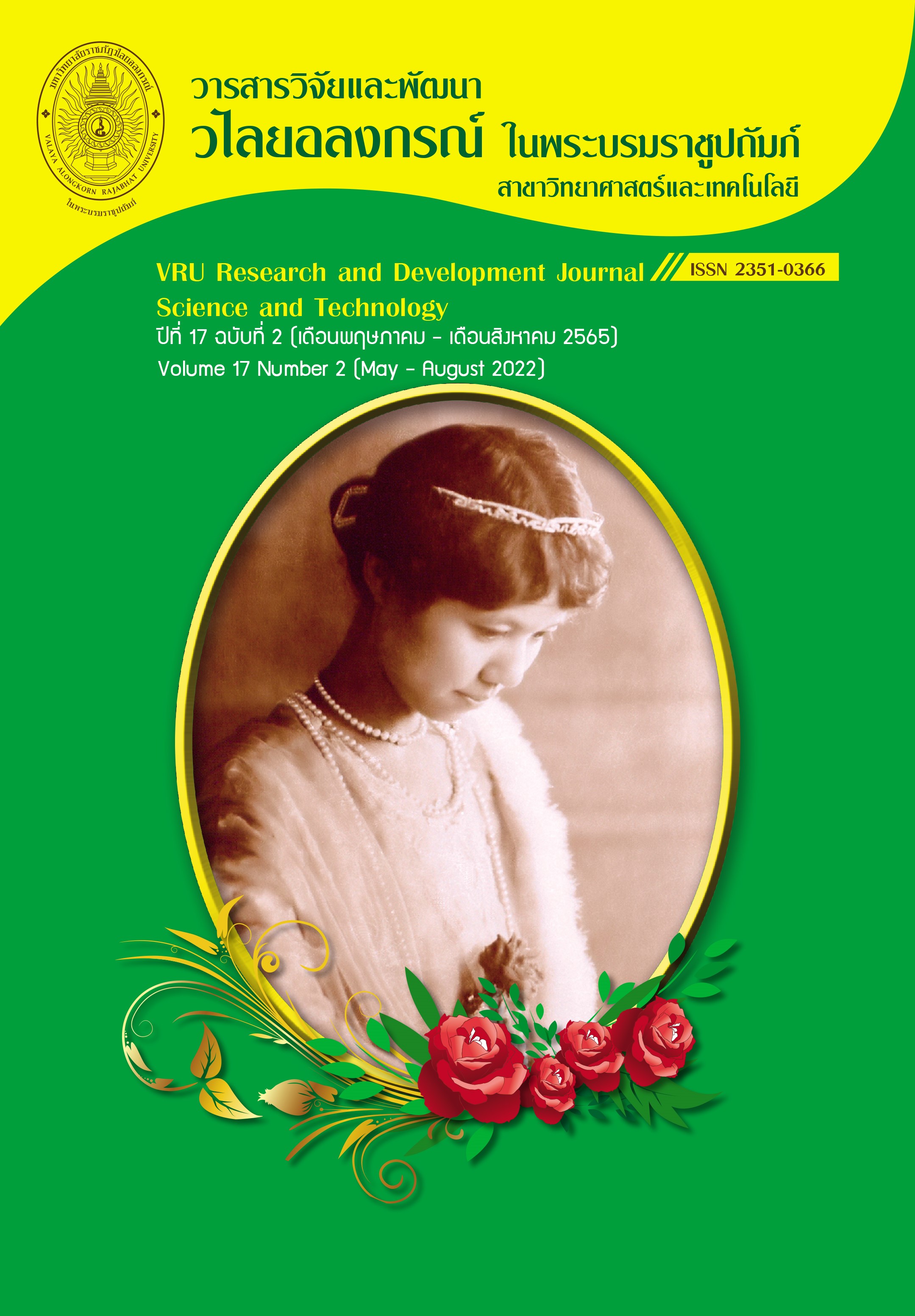FACTORS RELATED TO HERBEL USE BEHAVIORS TOWARDS SELF CARE OF ELDERLY IN THONG EN SUB-DISTRICT, IN BURI DISTRICT, SING BURI PROVINCE
Main Article Content
Abstract
This research was the cross-sectional survey aimed to studying the factors related to herbal use behaviors towards self care among the elderly in Thong En sub district, In Buri district, Sing Buri Province. The samples were 293 people. The data was collected by questionnaires consisted of 4 parts: the personal factor, the knowledge of herbal medicines, the attitude of using herbal medicines, and the herbal use behaviors towards self care. The data was analyzed by using frequency, percentage, mean, standard deviation, Pearson’s correlation coefficient, and Chi-square test for correlation.
The result revealed that the knowledge of herbal medicines was at a good level ( = 11.17, S.D. = 2.36), the attitude of using the herbal medicines was at a moderate level
( = 2.18, S.D. = 0.38), and the herbal use behaviors towards self care was at a moderate
( = 2.15, S.D. = 0.35). The factors related to herbal use behaviors towards self care included the knowledge on herbs which showed a positive correlation (r = 0.155) and the attitude to herbal use which showed a positive correlation (r = 0.496) at a statistically significant level of 0.05 (p-value = 0.008 and < 0.001, respectively).The research revealed that it is necessary to comprehensively and continuously promote and enhance knowledge of using herbal medicines, clear up the misunderstanding among themselves and others, promote a good attitude related to using herb medicines for building up confidence, reducing the risk of ignorance and bringing the elderly towards good health.
Downloads
Article Details
Copyright Notice
The copyright of research articles published in the VRU Research and Development Journal Science and Technology Journal belongs to the Research and Development Institute, Valaya Alongkorn Rajabhat University under the Royal Patronage. Reproduction of the content, in whole or in part, is prohibited without prior written permission from the university.
Responsibility
The content published in the VRU Research and Development Journal Science and Technology Journal is the sole responsibility of the author(s). The journal does not assume responsibility for errors arising from the printing process.
References
กรมกิจการผู้สูงอายุ. (2562). สถิติผู้สูงอายุ ณ วันที่ 28 กุมภาพันธ์ 2562 แยกตามตำบล. สืบค้นจาก http://www.dop.go.th/th/know/side/1/1/238
กรมพัฒนาการแพทย์แผนไทยและการแพทย์ทางเลือก. (2562). รายงานประจำปี 2562 กรมการแพทย์แผนไทยและการแพทย์ทางเลือก. สืบค้นจาก https://www.dtam.moph.go.th/E-Book/ DTAM_ Report_2562/DTAM_Report_2562.pdf
ชนิดา มัททวางกูร, ขวัญเรือน ก๋าวิตู, สุธิดา ดีหนู, และสิริณัฐ สินวรรณกุล. (2562). ปัจจัยที่มีความสัมพันธ์กับพฤติกรรมการใช้สมุนไพรของประชาชนในเขตภาษีเจริญ. วารสารพยาบาลศาสตร์มหาวิทยาลัยสยาม, 20(39), 99-109.
ปัทมา ศิริวรรณ. (2559). ความรู้ ทัศนคติ การรับรู้ และการใช้ยาสมุนไพรของผู้ให้บริการและผู้รับบริการในโรงพยาบาลแม่ทา อำเภอแม่ทา จังหวัดลำพูน. การค้นคว้าอิสระหลักสูตรสาธารณสุขศาสตรมหาบัณฑิต สาขาวิชาการจัดการสร้างเสริมสุขภาพ, มหาวิทยาลัยธรรมศาสตร์.
ปรารถนา เอนกปัญญากุล, และศศินิภา ศรีกัลยานิวาท. (2557). ปัจจัยที่ส่งผลต่อพฤติกรรมการทำวิจัยของบุคลากร คณะแพทยศาสตร์ มหาวิทยาลัยนเรศวร. Naresuan Phayao Journal, 7(3), 275–285.
ภิษณี วิจันทึก. (2562). ความรู้ ทัศนคติ และพฤติกรรมการใช้ผลิตภัณฑ์สมุนไพรของประชาชน บ้านหนองบัว ศาลา อำเภอเมือง จังหวัดนครราชสีมา. วารสารวิชาการสาธารณสุข, 28(2), 245-253.
โรสนานี เหมตระกูลวงศ์, กิตติพร เนาว์สุวรรณ, และจีราพัชร์ พลอยนิลเพชร. (2563). ปัจจัยที่มีความสัมพันธ์ต่อพฤติกรรมการใช้ยาสมุนไพรในการ ดูแลสุขภาพตนเองของประชาชนในเขตเทศบาลนครยะลา ตำบลสะเตง อำเภอเมือง จังหวัดยะลา. รายงานการประชุมหาดใหญ่วิชาการระดับชาติและนานาชาติครั้งที่ 11, 17 กรกฎาคม 2563 ณ มหาวิทยาลัยหาดใหญ่ จังหวัดสงขลา.
วิไลวรรณ ชัยณรงค์. (2554). ปัจจัยที่มีความสัมพันธ์กับพฤติกรรมการใช้สมุนไพรในการดูแลสุขภาพตนเองของประชาชนในเขต อำเภอธัญบุรี จังหวัดปทุมธานี. วิทยานิพนธ์วิทยาศาสตรมหาบัณฑิต, มหาวิทยาลัยเกษตรศาสตร์.
วิริญญา เมืองช้าง. (2560). ปัจจัยที่มีความสัมพันธ์กับพฤติกรรมการใช้สมุนไพรในการดูแลสุขภาพตนเองของประชาชนในอำเภอแม่ใจ จังหวัดพะเยา. วิทยานิพนธ์สาธารณสุขศาสตรมหาบัณฑิต,มหาวิทยาลัยธรรมศาสตร์.
สัณฐิตาพร กลิ่นทอง. (2560). พฤติกรรมการใช้สมุนไพรรักษาโรคของประชาชนในจังหวัดเพชรบุรี. รายงานการประชุมวิชาการระดับชาติราชภัฏเพชรบุรีวิจัยเพื่อแผ่นดินไทยที่ยั่งยืน ครั้งที่ 7
“สหวิทยาการ สู่ไทยแลนด์4.0”, 15 กรกฎาคม 2560 ณ มหาวิทยาลัยราชภัฏเพชรบุรี.
สุกิจ ไชยชมภู, พูนสุข ช่วยทอง, วิราสิริริ์ วสีวีรสิว์, และสุนันท์ ศลโกสุม. (2555). ปัจจัยที่มีความสัมพันธ์กับพฤติกรรมการใช้ยาสมุนไพรรักษาโรค ของประชาชาในเขต 11 กระทรวงสาธารณสุข. วารสารเกื้อการุณย์, 19(2), 60-74.
สาโรจน์ เพชรมณี, จินตนา เพชรมณี, ศิราสรณ์ บรรจงเกลี้ยง, อัจฉรา ศรีแสง, และศรัญญา สีทอง. (2564). ปัจจัยที่มีความสัมพันธ์กับพฤติกรรมการใช้สมุนไพรของประชาชน ชุมชนประตูช้างตก ตำบลไทยบุรี อำเภอท่าศาลา จังหวัดนครศรีธรรมราช. วารสารวิทยาลัยพยาบาลบรมราชชนนี สุพรรณบุรี, 4(2), 5-22.
Green, L. W. & Kreuter, M.W. (1991). Health Promotion Planning An Educational and Environment Approach. California: Mayfield Publishing.
Bloom, Benjamin S. J. (1975). Taxonomy of education objective, hand book1: Cognitive domain. New York: David Mckay.
Daniel, W. W. (1995). Biostatistics: A foundation for analysis in health sciences. New York: John Wiley.
Schwartz, N. E. (1975). Nutritional knowledge, attitudes, and practices of high school graduates. Journal of the American Dietetic Association, 66(1), 28-31.


